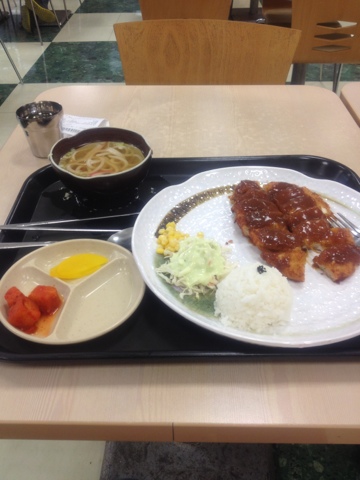Korea certainly hasn't avoided in getting several popular western culture franchises. There are 7-Elevens, Baskin Robbins, and Dunkin Donuts everywhere throughout the country. I think I've been to more of these businesses in Korea than I have in the United States!
There is one thing about coffee in Korea that puzzles me a bit. Rather than have regular drip coffee, most places (with Dunkin Donuts being one of he few exceptions) serve Americano (espresso with water added). I guess
It is easier to make since you then only buy espresso beans? I'm not sure exactly but that is how
Korea does it.
Friday, March 23, 2012
Brown Rice Green Tea
When I first came east I was quite excited about coming to a country that grows tea and has much better quality of tea than anywhere else in the world. However, what I noticed in the first couple weeks when brewing myself a cup of green tea with a tea bag that I had found in my cabinet, I realized that the green tea here is not just green tea: Its green tea with brown rice.
I was quite disappointed with this unexpected flavor and felt it tasted much too "grainy" than a cup of regular green tea. I later learned that you CAN buy plain green tea in bags or loose leaf, but you just have to watch the labels because most does have brown rice added to it.
But why do they add brown rice to begin with? It has taken me over 6 months to learn the reason and today one of my Korean co-teachers explained it to me: Because it adds fiber, so it is better for your digestive system.
I suppose I'm not too surprised. After all, Koreans in general are very health conscious and seem to have a natural remedy to prevent, help, or cure anything.
I was quite disappointed with this unexpected flavor and felt it tasted much too "grainy" than a cup of regular green tea. I later learned that you CAN buy plain green tea in bags or loose leaf, but you just have to watch the labels because most does have brown rice added to it.
But why do they add brown rice to begin with? It has taken me over 6 months to learn the reason and today one of my Korean co-teachers explained it to me: Because it adds fiber, so it is better for your digestive system.
I suppose I'm not too surprised. After all, Koreans in general are very health conscious and seem to have a natural remedy to prevent, help, or cure anything.
Thursday, March 22, 2012
Unexpected flavors of food
 Today I came in for lunch and had two particular items that looked quite familiar to what I might have in a meal back home: What appeared to be some sort of meat or chicken fillet and a fruit salad. What puzzled me, however, were the flavors and combinations of foods that I was not expecting. For instance, in this fruit salad that appears to have apples, raisins, grapes, and marshmallows there are certainly no grapes in it but rather tomatoes. The fruit salad itself is not very sweet either as one might be in the US. I could only subtly taste the marshmallow. The other was the little patties or fillets. My initial guess is that it was chicken with a honey mustard (since I have had other dishes here with honey mustard). However, this was a fish fillet and the sauce is mustard that seems to be mixed with some mayo so it isn't as strong.
Today I came in for lunch and had two particular items that looked quite familiar to what I might have in a meal back home: What appeared to be some sort of meat or chicken fillet and a fruit salad. What puzzled me, however, were the flavors and combinations of foods that I was not expecting. For instance, in this fruit salad that appears to have apples, raisins, grapes, and marshmallows there are certainly no grapes in it but rather tomatoes. The fruit salad itself is not very sweet either as one might be in the US. I could only subtly taste the marshmallow. The other was the little patties or fillets. My initial guess is that it was chicken with a honey mustard (since I have had other dishes here with honey mustard). However, this was a fish fillet and the sauce is mustard that seems to be mixed with some mayo so it isn't as strong.Where is the tartar sauce you ask? I don't think that exists here.
This is just one of the many food I've eaten here that had a flavor that I was not expecting. The one that I noticed early on was garlic bread. Naturally, as a westerner, you would expect garlic bread to taste garlic-y and a bit salty, perhaps. However, in Korea it is sweet. You still taste the garlic, but they seem to put some sort of syrup on it.
Lack of Co-Ed Classrooms and Schools in Korea
Every day at 8 AM I have an early morning conversation class with groups of about 10 middle school students. Today with my 3rd year students I had a discussion about how high school in Korea is different from the US.
One of the questions I asked the students was whether they would prefer to have separate boy and girl classes or boy and girl schools like in Korea or have all co-ed classes and schools like in the US. I asked this question to both the 2nd year and 3rd year classes, which were a mix of boys and girls though they sat on separate sides of the room. Though I did have a couple 3rd year boys that said they would prefer co-ed, in general the students preferred having separate classes and schools. I noticed that the girls especially preferred the classes to be separate.
When I asked the girls why I received responses such as: I feel more comfortable, boys cause too many disruptions, boys cause too much trouble, etc.
Based on how I have noticed the girls act in classes where there are mixed genders, I do feel that this is the case: The girls here don't feel comfortable with boys in the room. I have never see them interact with each other even if it is a co-ed class. I've also noticed that in these classes the boys do more talking and feel more comfortable, but the girls are quiet. It seems that only when the boys are gone that I can REALLY get them talking with me. I often feel like I have to pull answers out of them to answer because it is almost like they are embarrassed to talk when the boys are in the room with them.
It is quite a bit of a culture difference from the environment where I was brought up in the US, where it is normal to have guy-girl friendships and to sit next to and interact with each other in class.
One of the questions I asked the students was whether they would prefer to have separate boy and girl classes or boy and girl schools like in Korea or have all co-ed classes and schools like in the US. I asked this question to both the 2nd year and 3rd year classes, which were a mix of boys and girls though they sat on separate sides of the room. Though I did have a couple 3rd year boys that said they would prefer co-ed, in general the students preferred having separate classes and schools. I noticed that the girls especially preferred the classes to be separate.
When I asked the girls why I received responses such as: I feel more comfortable, boys cause too many disruptions, boys cause too much trouble, etc.
Based on how I have noticed the girls act in classes where there are mixed genders, I do feel that this is the case: The girls here don't feel comfortable with boys in the room. I have never see them interact with each other even if it is a co-ed class. I've also noticed that in these classes the boys do more talking and feel more comfortable, but the girls are quiet. It seems that only when the boys are gone that I can REALLY get them talking with me. I often feel like I have to pull answers out of them to answer because it is almost like they are embarrassed to talk when the boys are in the room with them.
It is quite a bit of a culture difference from the environment where I was brought up in the US, where it is normal to have guy-girl friendships and to sit next to and interact with each other in class.
Wednesday, March 21, 2012
Korea's School System: Part 2 - Elementary School
Though I haven't taught in an official Korean "Public Elementary School", I do have the experience of teaching at a Hagwon at this level so I do have an idea as to how the students are treated and taught at this level compared to in the US based on my experience and associating with some fellow foreigner friends. However, I will say before I get started that I'm sure there are variables that I may miss because I haven't taught or been in a true public elementary school.
The initial culture shock to most foreigners coming to Korea to teach at an elementary level is the lack of structure. You walk into school that first day and you're told to take off your shoes at the door and put on slippers. You think "Okay, I heard about this before coming here" so you were expecting this. Then you find your desk and start to prepare and look at your schedule and you have kids coming in the room to just "hang out" with you. They come in your room to ask you what you're doing, they ask you what you will be doing in class today, they sit on your lap, they want to play "rock, paper, scissors", they play games with each other, they give you candy... they basically do whatever they wish in the teacher's office. Coincidentally, the only time that they may NOT do this is if the foreign teacher watches the door and tells them "Go to playroom!" To someone from a western culture, this is absurd -- why on earth would anyone let little kids come into the teacher's office when they're supposed to be preparing for class? The Koreans think of nothing wrong with this... as they are just being kids and they are letting them.
With private institutions, the way the classes are organized exactly depends on the school. I know at Hagwon's and the private kindergarten and preschools, students move between classes. From my experience at these schools, they go to class with one teacher, may have a 10-15 minute break to run around the school and then the bell will ring again and they go to start their next class. Some Hagwon's are a bit different here where you have one teacher that has the same kids all day, so it depends on the school.
As far as public schools, the students have one Korean teacher all day but for English and Art they have the English and art teacher come into their classroom every day for these subjects.
The one thing that really stood out to me working with younger kids in Hagwons is that they never stand in lines. This MIGHT be different in public schools, but seeing how the culture functions it doesn't seem to be something that they do in schools (if they do, someone else can certainly clarify for me). I've never seen any teachers instruct students to "stand in single file line and walk down the hall".
Teachers Meetings
I've noticed a bit of a trend with public school teachers meetings in Korea: They always have food and they commonly have drinks. The food includes types like rice cakes, meat, fish, kimchi, fruits, and perhaps even some kimbop. What I find amusing, however, is that though you may have some orange juice to drink, they do also have makkoli (rice wine). Imagine bringing in bottles of Riesling or some other wine to a teachers meeting in the United States -- it would certainly be looked down upon in the conservative nature of American schools.
This is not to say that Korean schools are still not conservative in their own way (because in some regards they are seen as, perhaps, more conservative than schools in the US) but this is one example of something that is seen as perfectly fine in Korea but would never be thought of in the states.
This is not to say that Korean schools are still not conservative in their own way (because in some regards they are seen as, perhaps, more conservative than schools in the US) but this is one example of something that is seen as perfectly fine in Korea but would never be thought of in the states.
Tuesday, March 20, 2012
No "Lunch Duty"
It took me nearly 3 weeks of working at a Public Middle School to notice this: There is no lunch duty for teachers. In fact, what is interesting is that the teachers eat in the cafeteria WITH the students in their own little designated corner. Nobody watches the students or tells them what to do -- they know what to do and they just do it. The teachers go about eating their lunch and the students go about eating theirs. Nobody ever yells to "be quiet" or when to go in line to go back -- the students go up to get lunch completely on their own and then leave when finished so they are back in class. There is no structure to it whatsoever... everybody just simply eats lunch in peace. There's no stress or obstacle in it: You just eat lunch.
In fact, in hindsight, I do recall now asking some Korean students once if they ever participated in a "food fight" their quick reaction was "Gosh, I would never even think of doing that".
I suppose that after being here this long I really didn't think much of it because it's typical Korean way of doing things to have little to no structure. The teachers don't have any "duty" of any sort (lunch, bus, after school, etc.) -- they just teach. Heck, I don't even think my school has a master schedule yet as far as class times go and it's 3 weeks into the school year. Everybody just goes with the flow of what schedule they are told for that week.
In fact, in hindsight, I do recall now asking some Korean students once if they ever participated in a "food fight" their quick reaction was "Gosh, I would never even think of doing that".
I suppose that after being here this long I really didn't think much of it because it's typical Korean way of doing things to have little to no structure. The teachers don't have any "duty" of any sort (lunch, bus, after school, etc.) -- they just teach. Heck, I don't even think my school has a master schedule yet as far as class times go and it's 3 weeks into the school year. Everybody just goes with the flow of what schedule they are told for that week.
Sunday, March 18, 2012
Korean Reasoning
One of the puzzling things of living in Korea is their ways of reasoning (or, as it may be perhaps seen by a westerner as, lack thereof). Even after living here for 6 months it never fails to amaze me some days when going about the simplest tasks sometimes.
I will share a few stories to give an idea as to what I mean by this:
- This first story is one of my first episodes of coming to this realization. This took place last fall when I was with a friend and we decided to walk through some ancient tombs. Naturally, these grounds required a small pay for admittance. Luckily my friend was pretty fluent in Korean so communication wasn't a barrier. However, for some reason that day the man didn't have any change and had to go find some (the cost was only like 1,000 KRW each or something very small). Instead of having us wait until he ran over to grab some change, he just let us in and told us to pay when we got back. Of course, my friend and I are thinking to ourselves "1. Why would you not have change and 2. We could easily just walk in and then leave without paying, so why are you letting us in now." It worked out fine nonetheless.
These next two are two experiences that I've had on my own recently when shopping.
- I was out shopping with one of my co-teachers upon my arrival at my new apartment and I decided that I better buy a few bath towels. We found the bath towel section and there was a special sale price if you bought 3 of the larger towels. Naturally, I grab 3 different colors: pink, green, and blue. My co-teacher responds in saying "Oh I don't think you can get the discount that way. You have to get three of the same color." I'm puzzled with this issue because, regardless of color, all are on sale and all they would have to do on the check out is to scan the same one three times if the computer programming was an issue. My co-teacher found a worker to clarify and he said that I had to buy all of the same color because the computer wouldn't recognize the discount with three different colors. Needless to say, I just left it at that and disregarded the discount.
- For this last one I was shopping at the local E-mart to buy some weekly groceries. I was picking up a few things in the produce section and I grabbed a yellow bell pepper. They weren't pre-packaged, but I found a plastic bag and it put it in there in my traditional western-culture way. I'm thinking in my head that they have a chart with codes for all the produce as they do in any western culture grocery store to ring up the item. However, I get to the check out and the Korean lady at the check out asks me (in Korean) where the sticker is. I'm puzzled and a bit confused as to where I was even supposed to find a sticker to place on this pepper. "Why was it not on there to begin with? Why didn't they just pre-package it with the sticker on their to begin with? Why would they be expecting the customer to wander around and find a sticker to place on their produce item?" I'm thinking to myself. Needless to say, they had a lady in customer support run back to get a sticker for me so I could buy my bell pepper.
So there's just a few examples of how the reasoning of Koreans may seem a bit "backwards" to someone of a western culture perspective. This is not to say that either way of reasoning is either right or wrong, but rather a point in the difference between the two.
I will share a few stories to give an idea as to what I mean by this:
- This first story is one of my first episodes of coming to this realization. This took place last fall when I was with a friend and we decided to walk through some ancient tombs. Naturally, these grounds required a small pay for admittance. Luckily my friend was pretty fluent in Korean so communication wasn't a barrier. However, for some reason that day the man didn't have any change and had to go find some (the cost was only like 1,000 KRW each or something very small). Instead of having us wait until he ran over to grab some change, he just let us in and told us to pay when we got back. Of course, my friend and I are thinking to ourselves "1. Why would you not have change and 2. We could easily just walk in and then leave without paying, so why are you letting us in now." It worked out fine nonetheless.
These next two are two experiences that I've had on my own recently when shopping.
- I was out shopping with one of my co-teachers upon my arrival at my new apartment and I decided that I better buy a few bath towels. We found the bath towel section and there was a special sale price if you bought 3 of the larger towels. Naturally, I grab 3 different colors: pink, green, and blue. My co-teacher responds in saying "Oh I don't think you can get the discount that way. You have to get three of the same color." I'm puzzled with this issue because, regardless of color, all are on sale and all they would have to do on the check out is to scan the same one three times if the computer programming was an issue. My co-teacher found a worker to clarify and he said that I had to buy all of the same color because the computer wouldn't recognize the discount with three different colors. Needless to say, I just left it at that and disregarded the discount.
- For this last one I was shopping at the local E-mart to buy some weekly groceries. I was picking up a few things in the produce section and I grabbed a yellow bell pepper. They weren't pre-packaged, but I found a plastic bag and it put it in there in my traditional western-culture way. I'm thinking in my head that they have a chart with codes for all the produce as they do in any western culture grocery store to ring up the item. However, I get to the check out and the Korean lady at the check out asks me (in Korean) where the sticker is. I'm puzzled and a bit confused as to where I was even supposed to find a sticker to place on this pepper. "Why was it not on there to begin with? Why didn't they just pre-package it with the sticker on their to begin with? Why would they be expecting the customer to wander around and find a sticker to place on their produce item?" I'm thinking to myself. Needless to say, they had a lady in customer support run back to get a sticker for me so I could buy my bell pepper.
So there's just a few examples of how the reasoning of Koreans may seem a bit "backwards" to someone of a western culture perspective. This is not to say that either way of reasoning is either right or wrong, but rather a point in the difference between the two.
Friday, March 16, 2012
Eating live octopus
It was just your typical Friday afternoon: I was done with my classes for the day and just had little bits of prep to do for next week's classes. Today some of the students had brought in some food to the teachers' office for us to eat. I immediately saw the classic rice cakes and some raw fish (similar to the sushi that you get at a Japanese restaurant). "Most all of what I've already seen" I think to myself.. and then I look a little closer at that dish of squid and realize that it is definitely moving: Live octopus!
I was offered several times, but needless to say I politely declined and said I'll stick with the tasty rice cakes and orange juice. :-)
One of my English Korean co-teachers clarified for me that you do have to be sure to chew it very well when you eat it because you can choke on it, as the suckers may stick to your throat otherwise. The thought of this alone was enough to turn me away -- but at least now I can say that I've seen it!!
Sunday, March 11, 2012
Korea's "American Idol"
During my day I happened to get a sneak peak of a show that looked awfully familiar to a popular American reality show. You guessed it: Korea has their own version of American Idol as well. Their show is called "K-Pop Star" and they also have three judges. I must say -- even though I don't know enough Korean to know what they were saying, one of the judges did seem critical enough to pull off being considered as the Korean version of Simon.
Korean Graves
In Korea there are no cemeteries. Instead, they have small "tombs" for those that have past. Most all do not have headstones (in fact, I have only seen one that does). They have special locations and very large "tombs" for past kings and royalty. However, when it comes to the average person most are just buried on mountains like this one in the picture. Typically a family has their own hidden section ofthe mountain where their ancestors rest.
Friday, March 9, 2012
Pictures of Mokpo
This morning I went hiking with my Korean English co teachers. These are some of the pictures I took of the beautiful scenery.
Cheese-filled Pork Cutlet
Korea has many delicious meals. One that is great if your looking for a little cheese-fix (since there isn't much cheese here) is cheese pork cutlet. To order this in Korean you say "cheez-uh dun k-ah-s".
Korea's School System: Part 1 - Public Elementary, Middle, and High School Basics
For this post, I'm going to start to talk a little bit about Korea's school system and how it is setup. I'm putting this into parts because I'm sure that the longer I am here the more I will learn and discover, so this post is by no-means "all of it".
For starters, Korea has the main 3 levels of schooling: elementary, middle, and high school.
In Korea, they do not have kindergarten and preschool integrated in with the elementary schools (to my current knowledge). All kindergartens and preschool is at private institutions. To foreigners (as Korean's call "waygooks"), we may consider this as a "Hagwon", but after mentioning it to a few Koreans they quickly responded that (to them) these are not true Hagwons, but kindergarten institutes. (*Note: I will talk about what Hagwon's are later).
The school system is set up like this as far as ages and grades:
- Elementary school (start at age 7 and includes grades 1st through 6th).
- Middle school (start at age 13 and students go for 3 years)
- High school (start at age 16 and students go for 3 years)
(*Note: I'm listing the ages according to what their ages would be in a Western Culture rather than their "Korean age". Their Korean age would be one or two years older than this.)
Testing is heavy in the school system. To be admitted to middle school, students have to take an exam to see which middle school they will be placed at in their city. In the smaller towns like Gyeongju or Mokpo that I have worked in of about 250,000 people the city has about 15 or so middle schools. The schools are all set up according to the level of the students abilities. The same is true for high school as well, as the students have to take an entrance exam in order to know what high school they will be admitted to.
For middle school and high school, the schools are often divided into boys and girls schools as well. In the schools that do have both boys and girls in the same school, the classes are typically divided into separate boy and girl classes. However, I will say that in my classes in Mokpo I do have two classes that are a mix of boys and girls in my 3rd year middle school students. The reason for this is because, as a result of their English exam the previous school year to place students according to their abilities, the classes were going to be very small and came out uneven between boys and girls so I do have two classes as a mix. However, in these classes it is not like a class in the United States, as the boys and girls sit on opposite sides of the room.
I do believe that students also need to take an entrance exam for elementary school as well to know what middle school they go to. This is partially why (I would guess) that there is such a high demand for native English teachers in kindergarten institutes -- because there's just so many of them so gets can get into a good elementary school.
Also, it IS possible for students to just "fail" their entrance exam into elementary, middle, or high school. In these circumstances, the kids then either stay at the level they are at and learn more or (I suppose) just not go to school until they can pass the exam. This is really a huge deal though, because then this greatly declines their chances of ever going to college.
For starters, Korea has the main 3 levels of schooling: elementary, middle, and high school.
In Korea, they do not have kindergarten and preschool integrated in with the elementary schools (to my current knowledge). All kindergartens and preschool is at private institutions. To foreigners (as Korean's call "waygooks"), we may consider this as a "Hagwon", but after mentioning it to a few Koreans they quickly responded that (to them) these are not true Hagwons, but kindergarten institutes. (*Note: I will talk about what Hagwon's are later).
The school system is set up like this as far as ages and grades:
- Elementary school (start at age 7 and includes grades 1st through 6th).
- Middle school (start at age 13 and students go for 3 years)
- High school (start at age 16 and students go for 3 years)
(*Note: I'm listing the ages according to what their ages would be in a Western Culture rather than their "Korean age". Their Korean age would be one or two years older than this.)
Testing is heavy in the school system. To be admitted to middle school, students have to take an exam to see which middle school they will be placed at in their city. In the smaller towns like Gyeongju or Mokpo that I have worked in of about 250,000 people the city has about 15 or so middle schools. The schools are all set up according to the level of the students abilities. The same is true for high school as well, as the students have to take an entrance exam in order to know what high school they will be admitted to.
For middle school and high school, the schools are often divided into boys and girls schools as well. In the schools that do have both boys and girls in the same school, the classes are typically divided into separate boy and girl classes. However, I will say that in my classes in Mokpo I do have two classes that are a mix of boys and girls in my 3rd year middle school students. The reason for this is because, as a result of their English exam the previous school year to place students according to their abilities, the classes were going to be very small and came out uneven between boys and girls so I do have two classes as a mix. However, in these classes it is not like a class in the United States, as the boys and girls sit on opposite sides of the room.
I do believe that students also need to take an entrance exam for elementary school as well to know what middle school they go to. This is partially why (I would guess) that there is such a high demand for native English teachers in kindergarten institutes -- because there's just so many of them so gets can get into a good elementary school.
Also, it IS possible for students to just "fail" their entrance exam into elementary, middle, or high school. In these circumstances, the kids then either stay at the level they are at and learn more or (I suppose) just not go to school until they can pass the exam. This is really a huge deal though, because then this greatly declines their chances of ever going to college.
Thursday, March 8, 2012
How Korea does Yogurt
In korea they do yogurt a little different than in the USA. They do have regular cups of yogurt as you buy in the states but they also have the kind of yogurt that you drink. The picture here is just the Korean-ized version of the common yogurt brand Activia.
Friday, March 2, 2012
How Koreans eat meals
Most all Korean meals are eaten as a group. You don't have your own plate of food. Instead, one meal is ordered that you cook in front of you and eat as you go.
What i find interesting, however, is watching situations like in the picture. It is a more western-style restaurant and one ordered Alfredo pasta and the other ordered a salad. Rather than eat their own separate meals the koreans still share and "split" their meals. It all goes back to their cultural sense of community.
What i find interesting, however, is watching situations like in the picture. It is a more western-style restaurant and one ordered Alfredo pasta and the other ordered a salad. Rather than eat their own separate meals the koreans still share and "split" their meals. It all goes back to their cultural sense of community.
How Korea serves green tea
This is just one example to give an idea of how Koreans serve green tea, which is 녹차 (pronounced nok cha) in Korean. Tea bags are never used in restaurants (only on occasion). They typically have a slot in the tea pot to seep the tea leaves. If it is an individual cup, you often remove that to drink but in a pot (like this instance) not always.
Honestly, this one is probably the neatest I've had so far --I've never had a timer before! This one was of really good quality too, as it did not have grains added to it as many places here do for some reason. It is one of the things I may never understand is why they must ruin (in my opinion) such perfect quality tea.
Honestly, this one is probably the neatest I've had so far --I've never had a timer before! This one was of really good quality too, as it did not have grains added to it as many places here do for some reason. It is one of the things I may never understand is why they must ruin (in my opinion) such perfect quality tea.
Subscribe to:
Posts (Atom)











